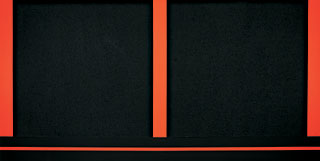|
| |
 |
|

|

Two Cells with Conduit, 1987. Day-Glo, acrylic, and Roll-a-Tex on canvas, two panels, overall: 78 5/8 x 155 1/8 inches. Solomon R. Guggenheim Museum, New York. Purchased with funds contributed by Denise and Andrew Saul and Ellyn and Saul Dennison. 87.3550
|

Two Cells with Conduit resembles the paintings of Ellsworth Kelly and Brice Marden, but while the work of these artists may be described as "abstract," Peter Halley prefers the designation "diagrammatic" for his precise, austere arrangements. He conceives of his vocabulary of squares, bars, and rectangles as coded referents to the way in which geometry pervades our world. Life in late-capitalist culture, according to Halley's own critical writing, has been inscribed and circumscribed by geometric networks such as the urban grid, the office tower, the high-rise apartment building, and the correctional institution. His morphological investigations also focus on the traditional manner in which geometric abstraction has been perceived. By invoking the formal attributes of Minimalist art—rigid planes of color, unitary shapes, and nonhierarchical compositions—and mapping a narrative sensibility onto them, Halley calls the supposed neutrality of such art into question.
In his exploration of postindustrial culture—with its reliance on information systems, media representation, and an economy that privileges image over product—Halley has created schematized depictions of enclosed spaces, linked to the world through a network of electronic, telephonic, and fiber-optic conduits. The division of Two Cells with Conduit into two discrete portions suggests an architectural section; the squares above represent prototypical urban dwellings while the line below indicates the hidden, technological underworld of pipes, cables, and wires connecting them. Begun in 1981, Halley's cell-and-conduit paintings demonstrate what he has described as the "seductive" geometry of 1980s culture, epitomized by the irreal space of the video game. The Day-Glo colors and ersatz stucco paint—known as Roll-a-Tex—make these canvases into emblems of a social reality, in which artifice replaces empirical experience.
|
|